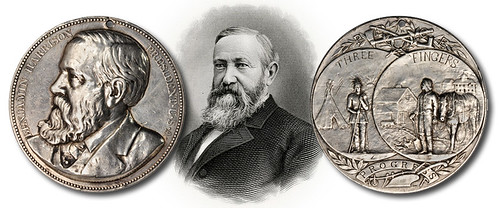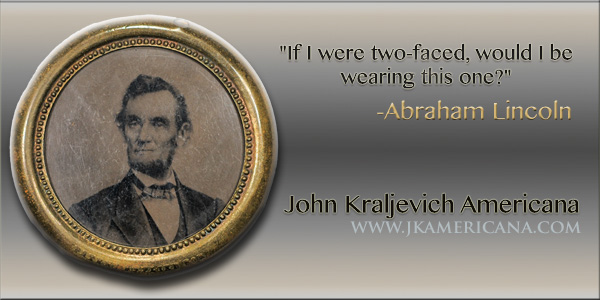
PREV ARTICLE
NEXT ARTICLE
FULL ISSUE
PREV FULL ISSUE
THE CHIEF THREE FINGERS MEDALStack's Bowers has a new ad in this week's issue, soliciting consignments
for their upcoming Americana sale. I was unfamiliar with the medal pictured in the ad, and wondered
what the heck the words "THREE FINGERS" meant. Well, Greg Cohen & John Pack explain
it in their October 30, 2014 blog post. Here's an excerpt. -Editor
 Undated (Circa 1890-1893) Benjamin Harrison Indian Peace Medal. The Only Size. Silver. 76.7 mm, 3.75 to 4.05 mm thick. 3,463.7 grains. Obverse Signed C.E. BARBER F. Julian IP-48. The Benjamin Harrison medals marked a departure from the oval style medals that had been adopted for the Rutherford Hayes, James Garfield, Chester Arthur and Grover Cleveland administrations. This was reportedly a reaction to requests from a delegation of four Oto and Missouri Indians who visited Washington in 1890. They specifically asked for round medals bearing the portrait of the sitting president. According to the account published by Francis Paul Prucha in his Indian Peace Medals in American History, the Oto and Missouri visitors were so adamant about the specific shape and size of the medals that they offered to pay the costs of the medals themselves. This was likely their answer to resistance from the Commissioner of Indian Affairs, who would have realized the bureaucratic difficulty of altering the adopted style of the official medals and probably attempted to dissuade them. Nonetheless, the request was made through proper channels to the Mint, and Mint officials complied. The Director of the Mint requested of the Office of Indian Affairs that they propose a new design for the reverse of the medals. A sketch was supplied which was intended to illustrate “progress” in the Native American’s adaptations to a way of life including “a civilized house and occupation,” though it was considered only a rough attempt to provide an idea of what would be desirable. A design by Charles Barber was proposed, found agreeable to all concerned, and adopted on May 12, 1890. On October 25, 1890, the first of the round medals, five in number, were forwarded to the Oto and Missouri Indians who had made the original request. In November, 1890, 18 more medals were sent to be distributed to members of the Cheyenne and Arapahoe who had agreed to sell vast lands in Indian Territory to the United States. As noted in Prucha, “some of these medals had the names of the recipients engraved on the reverse.” Five of the seven known medals are engraved to the recipients or to names of other members of the Cheyenne and Arapahoe. The present medal is among them, engraved with prominence, THREE / FINGERS, in letters arcing across the upper portions of the two large circles in the reverse design. Three Fingers, a Cheyenne Chief well documented in the historical photographic record, is not listed among the known original recipients. However, careful study of the medal itself reveals an earlier engraving, largely effaced. In the field below FINGERS can be seen the faint letters of BUFFALO, and just after, very faint remnants of MEAT. It seems, therefore, that this medal was originally Buffalo Meat’s medal, one of the documented recipients. It is unclear as to why the name was altered, but the medal obviously became the property of Three Fingers at some point. There are superb photographic portraits of him wearing this medal. The men were contemporaries, and are photographed together in images taken in Washington, in 1895. In one of them, they appear alongside Wolf Robe, another recipient of the Harrison medal. Three Fingers is reported to have died in 1917 at the age of 58, and is buried at the City Cemetery at Kingfisher, Oklahoma. Buffalo Meat is a much better documented character. He was born in 1847 or 1849, depending upon the source, and also died near Kingfisher, of tuberculosis, in 1917. The 1895 photograph of Buffalo Meat, Three Fingers and Wolf Robe is interesting in the subtle clues it yields. Buffalo Meat is dressed in European attire, a black suit, bow tie and broad brimmed black hat. Three Fingers and Wolf Robe are in native Cheyenne attire and only Wolf Robe wears his Harrison medal. To read the complete article, see:
See the complete article for more information, and the complete list of
recipients. It's a colorful list of names, including Starving Elk, Bull Chip, Cut Nose, Black
Coyote, and Buffalo Meat. -Editor
 Wayne Homren, Editor The Numismatic Bibliomania Society is a non-profit organization promoting numismatic literature. See our web site at coinbooks.org. To submit items for publication in The E-Sylum, write to the Editor at this address: whomren@gmail.com To subscribe go to: https://my.binhost.com/lists/listinfo/esylum All Rights Reserved. NBS Home Page Contact the NBS webmaster 
|